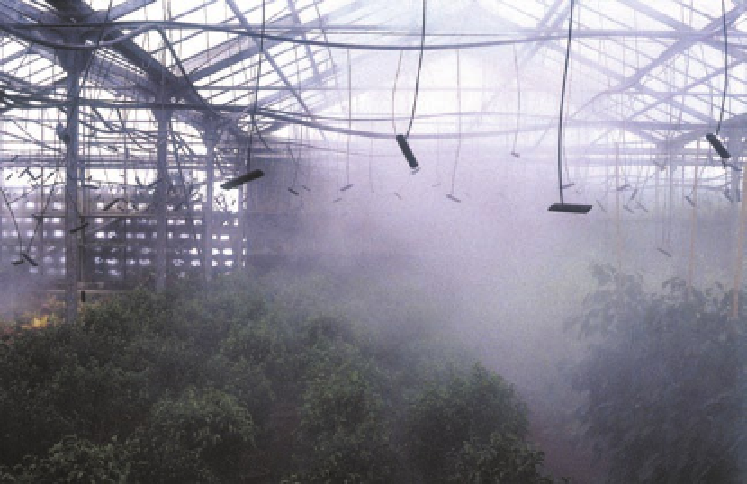Agriculture Reference
In-Depth Information
Photo 8.5.
Greenhouse water fogging.
canopy surface, requiring that this excess
water be carefully managed to prevent dis-
eases and crop damage (Conellan, 2002).
The first effect of water fogging or mist-
ing is the cooling of the air by evaporation,
as 2.45 × 10
3
J g
−1
of heat energy are extracted.
The cooled air (more dense) falls down and
induces a convective movement. If the fog-
ging system is properly regulated, the water
will not reach the plants. Furthermore, fog-
ging provides additional relief to plants
from too high temperatures because it cre-
ates some degree of shading.
A negative effect of fine fogging is that
it decreases PAR radiation (Urban and
Langelez, 1992), but the decrease is to a far
less extent than that caused by whitewash
or other types of shading.
There are three main fog-mist systems:
(i) water at high pressure (fogging); (ii) water
at low pressure (misting); and (iii) air/water
systems.
of 1 mm; and (ii) the needle type which
produces droplets smaller than 10 mm. The
latter is the most commonly used in sophis-
ticated greenhouses.
The flow of these diffusers is around
7 l h
−1
, with a density of 0.06-0.1 diffusers
in a square metre, and the water use can be
as high as 2.5-4.2 l m
−2
day
−1
, for an average
of 6 h of daily operation (Urban, 1997a). Fog
system consumption may be as high as half
of the water used for irrigation during the
summer.
The water must be of very good quality
with a pre-filtering from 50 to 100 mm, fol-
lowed by a filtering from 0.5 to 5 mm. In
waters with bicarbonates, acid must be
injected to decrease the pH to 6.6-6.8. If the
salt content in the water is high (more than
0.7 dS m
−1
) it will have to be desalinated, for
which reverse osmosis is the usual system
(Urban, 1997a). In practice, using rainfall
water is the most functional, to avoid block-
ages. Desalinated water contains bicarbo-
nates and its buffer capacity is drastically
reduced and when the droplets come in
contact the air, they absorb CO
2
, decreasing
the pH below 5, and could potentially
become corrosive (Urban, 1997a).
Any obstructions in the water flow in-
duce an increase in the size of the droplets,
High pressure systems (fogging)
Their working pressure is higher than
7 MPa. The pipes must be of copper or steel.
There are two types of diffusers (nozzles):
(i) the type with a turbulence chamber
which provides a droplet size in the order

